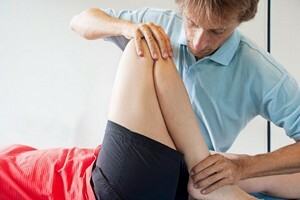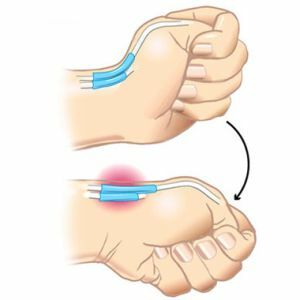 For the first time in our country about the Tietz Syndrome, as an independent disease, they started talking only in 1921.
For the first time in our country about the Tietz Syndrome, as an independent disease, they started talking only in 1921.
Despite almost 100-year observation period to a common opinion about the causes of the appearance of pathology physicians did not come.
In specialized medical literature, in addition to the official name "Titze Syndrome", it can be found under other names: rib chondritis, rib dystrophy or perichondritis.
How the disease develops
The disease is an inflammation of the connective tissue, manifested by the thickening and soreness of the cartilaginous tissue in the upper part of the sternum.
Men and women fall into the risk group, the age group of which varies within the limits of 20-40 years and whose work or sports activity is characterized by increased physical exertion.
As the practice of treatment shows, in most cases, the rib chondrite has a one-sided character and is formed on the left side of the thorax.
With regard to the percentage of localization of foci of pathology, it looks as follows:
- zone of cartilage of 2nd rib - 60%;
- cartilage zone III-IV ribs - 30%;
- zone of cartilage I, V, VI ribs about 10%.
As a result of damage to the perichondrium located in the zone of the upper ribs, the supply of hyaline cartilage is disturbed. 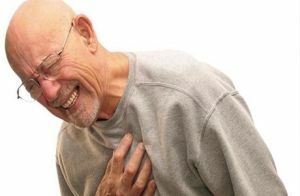
A consequence of this pathology is aseptic inflammation, which occurs directly in the cells of the cartilaginous tissue( chondroplast).
A few months after the onset of the disease in the inflamed rib cartilage, dystrophic disturbances are observed: changes in the size and arrangement of the cartilage are noticeable.
In damaged cartilage, bone density appears, which contributes to the development of visible sternum deformity.
Symptoms of the Tietze Syndrome
Symptoms of the Tietz syndrome occur unexpectedly and are characterized by a gradual increase in the pain syndrome in the affected area.
After a while( from a couple of hours to several days), a dense tumor forms in the area of the inflamed rib. Then it begins to occupy the entire intercostal area and reaches a height of 0.5 cm to 3 cm relative to the chest wall.
As the pathology develops, it is difficult for the patient to lie on his side, to make movements with his hands and body. Also, the pain syndrome increases during coughing, sneezing and laughing.
With further deterioration of the patient's condition, discomfort is already strongly felt in the neck, arms, shoulder blades and shoulder-straps.
Similar manifestations can bother a person long enough. The syndrome is characterized by repeated irregular irregular periods, the duration of which is from a couple of days to several days.
But a month later, a recession may occur, and bright symptoms pass by themselves.
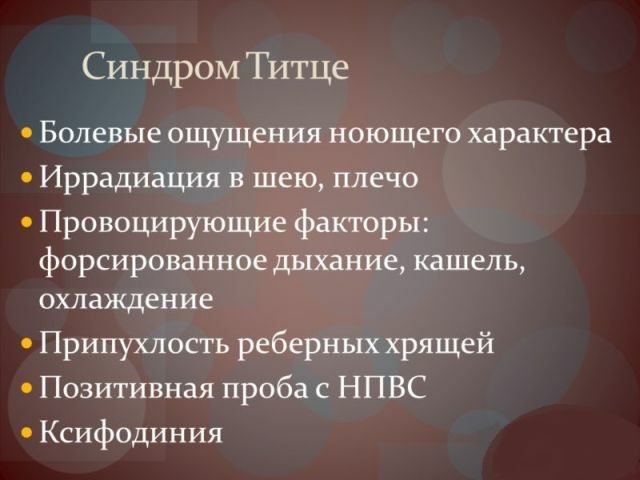
Common signs of costal chondrites include the following manifestations:
- a feeling of anxiety accompanying irritability and turning into fear;
- insomnia;
- tachycardia;
- shortness of breath;
- impaired appetite;
- fever on the inflamed area;
- skin hyperemia;
- severe swelling.
Causes of the disease
The main reason for the appearance of the disease was the researcher of this disease by the German surgeon Tietze. This is the disorder of the metabolic processes , which is the result of improper calcium metabolism and insufficient amounts of vitamins A and C.
However, almost a century of treatment of rib chondritis showed that itnot the only circumstance provoking this disease.
Modern medicine puts forward a few more theories:
- Strong physical activity of the , which affects the entire area of the shoulder girdle and sternum.
- Frequent injuries and bruises of the sternum , which in most cases suffer athletes;
- Autoimmune diseases .The prerequisite for the development of costal chondritis can be as various allergies, infections and diseases of the respiratory system, and the failure of the protective functions of the body;
- Disturbance of metabolic processes in connective tissues .Inflammation can begin after an early transfer of arthrosis, arthritis, collagenosis, etc.
Diagnostic tests of
A characteristic feature of the development of the disease is that in some laboratory studies, it is not possible to detect significant anomalies.
Titze syndrome is found only with dynamic observation. Often, the patient is misdiagnosed based on other symptoms. Therefore, when examining the patient is recommended to conduct parallel diagnosis for the presence of other types of pathologies.
MRI, computerized tomography and ultrasound examination of the thoracic cavity are prescribed to exclude any diagnosis.
The insidiousness of the disease consists in the fact that at the initial stage it is very difficult to determine even in the case of X-ray examination.
Pathological changes in the cartilaginous tissue become noticeable only with the formation of thickening and the dehuling of the perichondrium. And in neglected states on the affected ribs, small deposits will be easily seen, which contribute to the reduction of the intercostal space.

The photo shows where the Titze syndrome is located
Treatment of the disease
Timely and correctly administered treatment, Synder Tietze gives a fairly optimistic prognosis. But as for the surgical intervention, it is an extreme measure and is prescribed only in exceptional cases.
First of all, the patient is recommended to limit physical activity. A good effect is achieved when the hand is immobilized from the side of inflammation for 7-10 days.
Special attention is paid to the patient's nutrition. A high-grade and enriched with mineral supplements diet helps to strengthen and restore cartilaginous tissue. Also, the patient is shown taking tablets of non-steroidal anti-inflammatory drugs or they are replaced with ointments and gels.
With severe pain, the patient receives a course of novocaine intercostal injections with the administration of glucocorticoid hormones to the inflammation zone at regular intervals.
As a dissolving agent is used a composition consisting of a solution of iodine, sodium salicylate and water. It takes a potion of 1 tsp per day, and for better absorption of components, wash down with milk. After eliminating the pain syndrome, the patient can proceed to physiotherapeutic procedures.
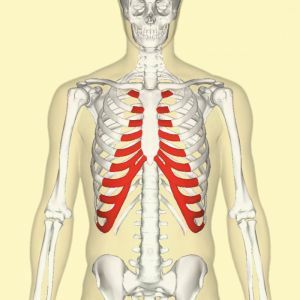 In case of ineffectiveness of conservative treatment, a surgical operation can be shown to the patient. Also in it, the need arises with severe deformation of the chest cavity.
In case of ineffectiveness of conservative treatment, a surgical operation can be shown to the patient. Also in it, the need arises with severe deformation of the chest cavity.
Do not hope that the disease will pass by itself. The recession period is not a sign of recovery.
Therefore, a specialist advises not to postpone his visit to the doctor if there are unclear chest pains. If you ignore such symptoms, chances are high that the rib chondrite will acquire a chronic form.
And in some cases the disease can cause disability and as a consequence - disability .

